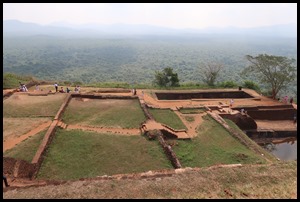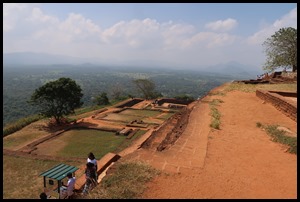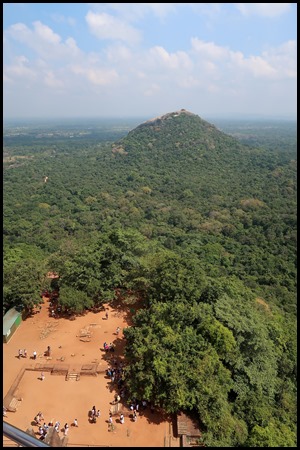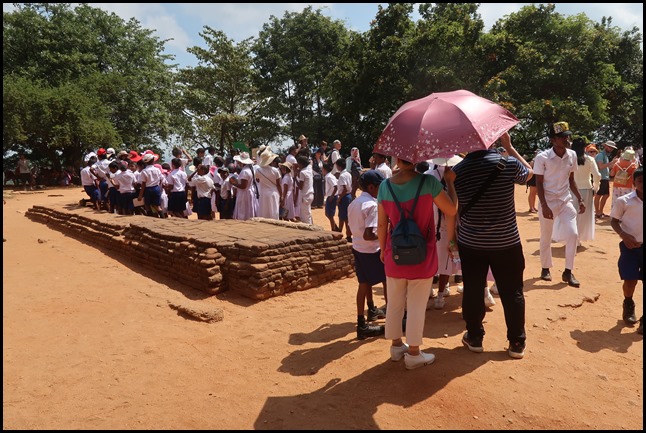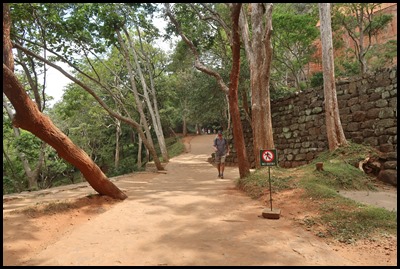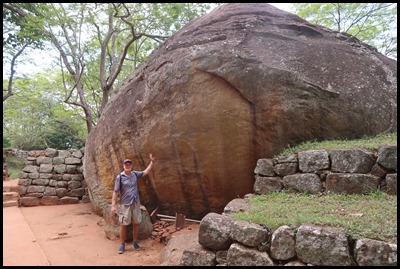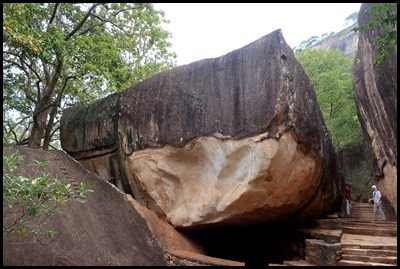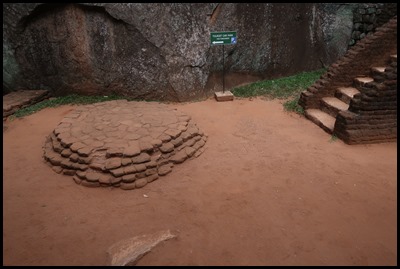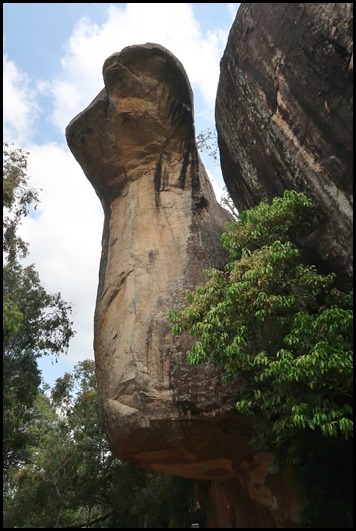Lion's Paw to the Top

|
Lion's Paw to the Top of
Sigiriya – Lion Rock
 We looked down as we climbed the
steps to the top of Lion Rock. We had a good view of the lion paws and also of the ‘first aid hut’....... not always
manned and Bear has read of people getting in trouble with many
stings......(wasps, bees and hornets), we saw none on our visit.
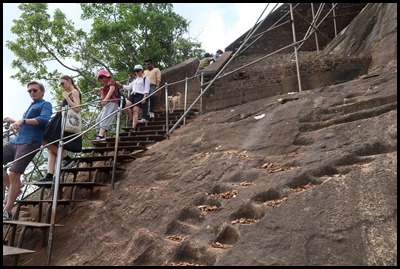  Up we went,
very amusing to watch one of the wild dogs who saw
himself as a monkey patrol officer.
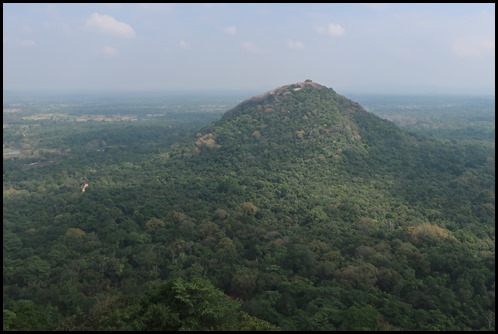 Aligala, a smaller rock outcrop seen
here to the east of Sigiriya, has a cave that has been used for over 3,500
years.
 The last few
steps, we hope....
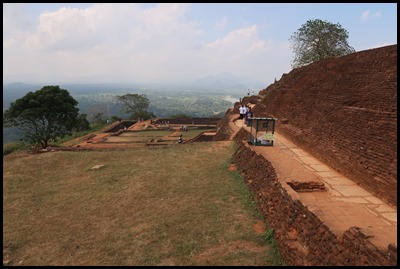 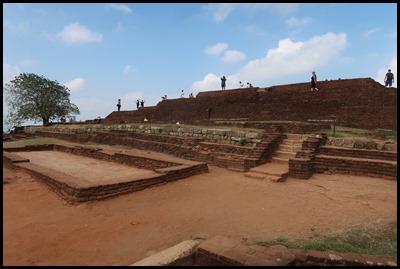 We sat for a
while taking in this terrace before climbing yet more
steps. Since 3rd century BC the rocky plateau of Sigiriya served as a
monastery. Taken from our pamphlet: King Kasyapa I (AD 477 – 495) was a son of
King Dhatusena (AD 459 – 477) by a lesser queen, hence his right to the throne
was not a strong one. Assuming the kingship by a palace conspiracy, which led to
the execution of his father, Kasyapa chose to make Sigiriya his seat of
administration and reigned for eighteen years. According to the eminent
archaeologist Prof Senerat Paranavitana, Sigiriya reflects the sensuousness of a
pleasure loving king, who modeled the city on the mythical Alakamanda of the god
Kuvera. This capital city was short lived and ended abruptly, when Mugalan, the
rightful heir to the throne and Kasyapa’s half-brother. succeeded him. Mugalan
however, opted not to reign from Sigiriya and he converted it again into a
Buddhist monastery. This second phase of the Buddhist monastery appears to have
lasted up to the 12th or 13th centuries AD. After this period, Sigiriya was
completely abandoned and was swallowed up by the surrounding jungle, forgotten
and quite alone in its glory.
   We bimbled to the end of this terrace
(facing south), looked down and saw the king’s swimming pool. It is worth mentioning that Lion Rock
is featured in the Duran Duran video Save a Prayer.
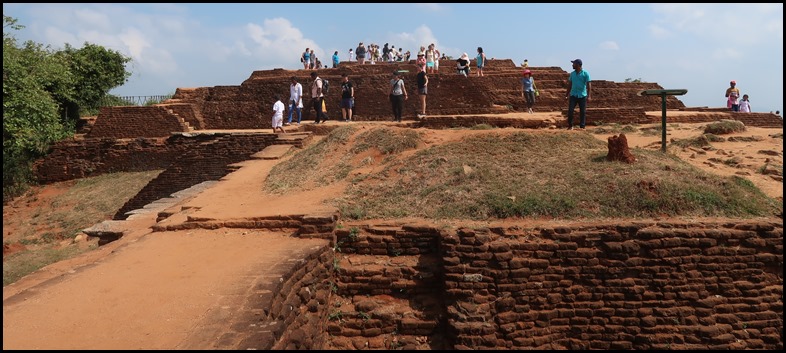 Looking north we could see the
important parts of the palace on higher ground (yet
more steps).
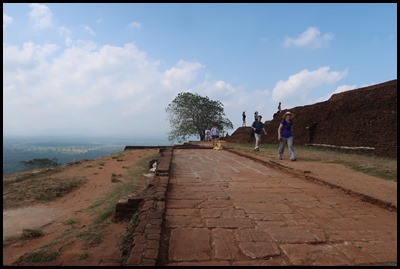  East Palace
Complex and a water cistern.
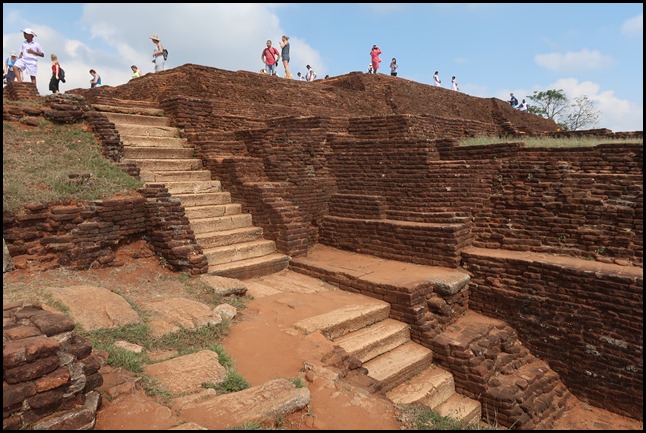 The buildings and gardens of Sigiriya show that the creators of this amazing architectural monument used unique and creative technical skills and technologies. The construction of such a monument on a massive rock approximately 200 meters higher from the surrounding landscape required advanced architectural and engineering skills. We were simply in awe of getting the bricks up here.
Bear sits in the Palace Reception Hall. The next layer – the Assembly Hall.
The Central Palace.
We took one last turn around at the top and began our descent.
I love this picture, it really shows the way down.
Half way down to Lion’s Paw Terrace another view of Aligala, Looking up a good view of the original steps used by the old inhabitants. A dozing lady took no notice of all the people passing inches away.
Don’t know how this numpty thinks she will carry her umbrella up the narrow steps we have just come down......Lion’s Paw terrace now had a full school in the queue.
After many steps it was nice to do a bit on the flat. Bear then found a boulder to hug.
This is regarded as the audience hall belonging to the royal city complex of King Kasyapa. This is on a flattened summit of a boulder, a natural split section of a rock in front. The main seat at the southern end is carved out of the living rock and others on either side, though carved out of the living rock, have certain parts made separately and fitted onto them. The small square holes on the surface of the flattened boulder suggest that there had been a roof to this hall supported by timber pillars.
We thought it was quite spectacular when we saw the audience hall boulder from the other side.
Asana Cave: This is a cave with a drip-ledge, and it takes the name from the seat (asana) inside, carved out of living rock. This has been made for the use of meditating monks when Sigiriya was a monastery before Kasyapa. Layers of painting belonging to several periods could be seen here. A striking feature is the presence among the paintings of a few graffiti belonging to the 8-9 centuries AD. The next bit down I couldn’t find an information board.
I couldn't find a person to show how huge this rock stood but I did find an information board: This is known by this name because of the natural cobra-hood shape of the cave. It is a cave with drip-ledges that had been used as a dwelling for the Sangha during the first monastic phase before Kasyapa. According to the early-brahmi inscription here, (3 – 1 centuries BC) this cave has been donated by chieftain ‘Naguliya’. It is suggested that the painting on the ceiling with a decorative motif belongs to the 6 – 7 centuries AD. An excavation carried out in front of the cave revealed nine human skeletons.
Last few steps down, then a cold water from a seller, a fridge magnet heavily bartered for and a short bimble to the outward bound car park and back in the van with Youssef and his co-pilot.
ALL IN ALL AN AMAZING ACHIEVEMENT FOR THE TIME HOW ON EARTH DID THEY GET ALL THE BRICKS TO THE TOP |



